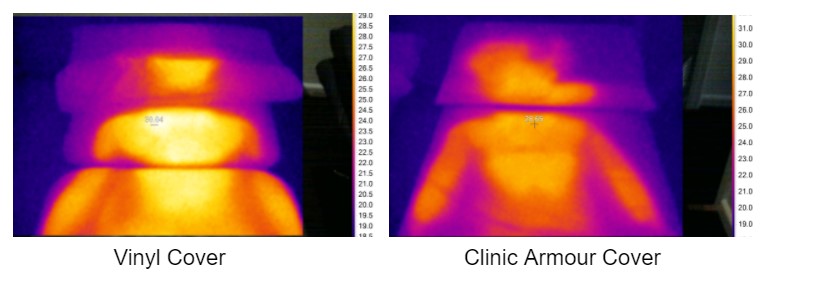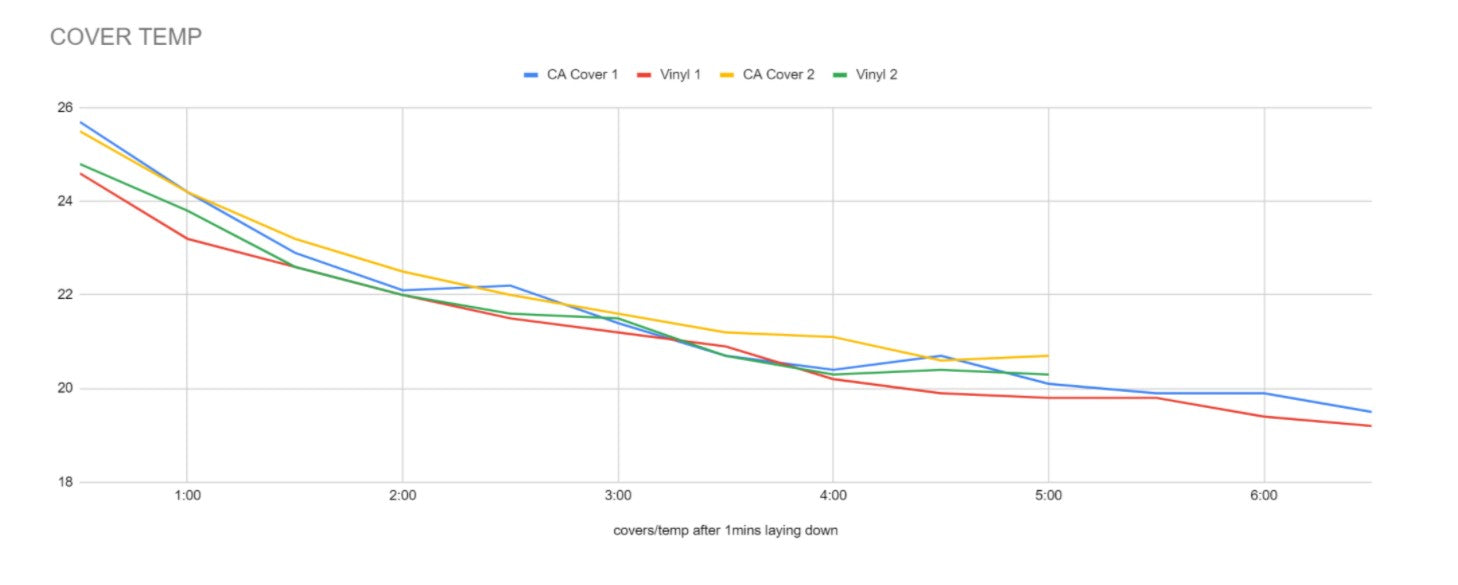Thermal Properties of Clinic Armour
After months of great feedback from patients, saying that the material is “soft”, “comfortable”, “not cold, not hot” we decided to test the thermal properties of the material we use exclusively with our Clinic Armour products.
Testing thermal properties is a science and somewhat difficult. Exposing a material to temperature will ultimately see the material reach the same temperature as the environment.
The science is the conductivity of the material, the rate of heating and cooling.
Our testing looked examined the following scenarios:
- Room temperature heating versus material temperature
- The temperature of Clinic Armour bed and pillow covers after 1 minute of laying supine compared to a cotton pillow cover and vinyl bed
- The temperature of the bed covers after 7 minutes of laying supine compared to vinyl covers
We used thermal cameras with a high sensitivity to compare the materials of Vinyl versus Clinic Armour bed covers and Cotton Pillow covers versus Clinic Armour Pillow covers. The pillows used were identical Easy Sleeperr memory foam pillows. Thermal imaging is an excellent reassure of patient contact.

Results:
Summary of Cover:
- At room temp of 19oC the Clinic Armour cover was 0.8oC warmer than the vinyl
- As the room heated the CA was slower to heat up than Vinyl
- At room temp of 22.5oC the Clinic Armour cover was 1.5oC cooler than a Vinyl bed
- The Clinic Armour cover is less conductive to temperature when a room is heating from an in-room ceiling outlet (heat omitted at 28.5oC evenly across beds)
See image below- The bed on the left an uncovered Vinyl bed. The one on the right is a bed with a Clinic Armour examination table. Note the significantly reduced colour which reflects the lower temperature.


- Summary of Pillow Type versus Room Temperature
Summary of Pillow:
- At room temp of 19oC the Clinic Armour pillow cover was 0.6oC cooler than the cotton cover.
- As the room heated the CA was slower to heat up than cotton pillow.
- At room temp of 22.5oC the Clinic Armour cover was 1.0oC cooler than a cotton pillow cover.
- The Clinic Armour cover is less conductive to temperature when a room is heating from an in-room ceiling outlet (heat omitted at 28.5oC evenly across beds) than cotton.

7 minute laying supine- max temp attained.
The same patient lay supine on a vinyl bed for 7 minutes then a bed with Clinic Armour cover for the same duration. A timer was used.
The maximum temperature of the cover/bed was taken at the end of the test.

- The maximum temperature of a Vinyl bed was 30.1oC.
- The maximum temperature of the Clinic Armour cover was 28.6oC

Summary: The material of the Clinic Armour cover is less conductive than Vinyl and as a result, the contact temperature was 1.5oC cooler after 7 minutes of lying supine.
Rate of Cooling after 1 minute contact
The temperature of both the Vinyl bed with a Cotton Pillow was compared to a Clinic Armour covers and Pillow. This test was reproduced on two occasions with a starting pillow temperature of 18.3oC for Clinic Armour Bed and Pillow and Vinyl Bed and 18.5oC for the cotton pillow cover.
The rate of cooling was not seen to vary much between products. In the time of 1-minute contact the Clinic Armour covers were higher than the temperature of Vinyl and significantly higher than a cotton pillow cover. This seems to show that when the direct temperature is applied the surface warms quicker than Vinyl or cotton.


It should be noted than will all efforts were made to conduct the test in a controlled environment it was conducted internally by Clinic Armour members. We used A FLUKE laser thermal camera which has a +/-0.1oC calibration rating. More extensive testing independent testing would be the next step to repeat and prove the above results. A full record of 180 thermal images with measured temperatures and camera calibration has been downloaded and saved.
Conclusion
Patients who report improved comfort may find the above results support:
- Clinic Armour products do not reach an as high surface temperature as Vinyl covers after 7 minutes of laying down.
- Clinic Armour products appear to respond to direct body temperature mirroring in a 1-minute test over Vinyl beds. This is likely due to the thin barrier.
- Clinic Armour is not as successive to air heating and may stay warmer at lower room temperatures and maybe cooler when a room is heating to higher temperatures.
